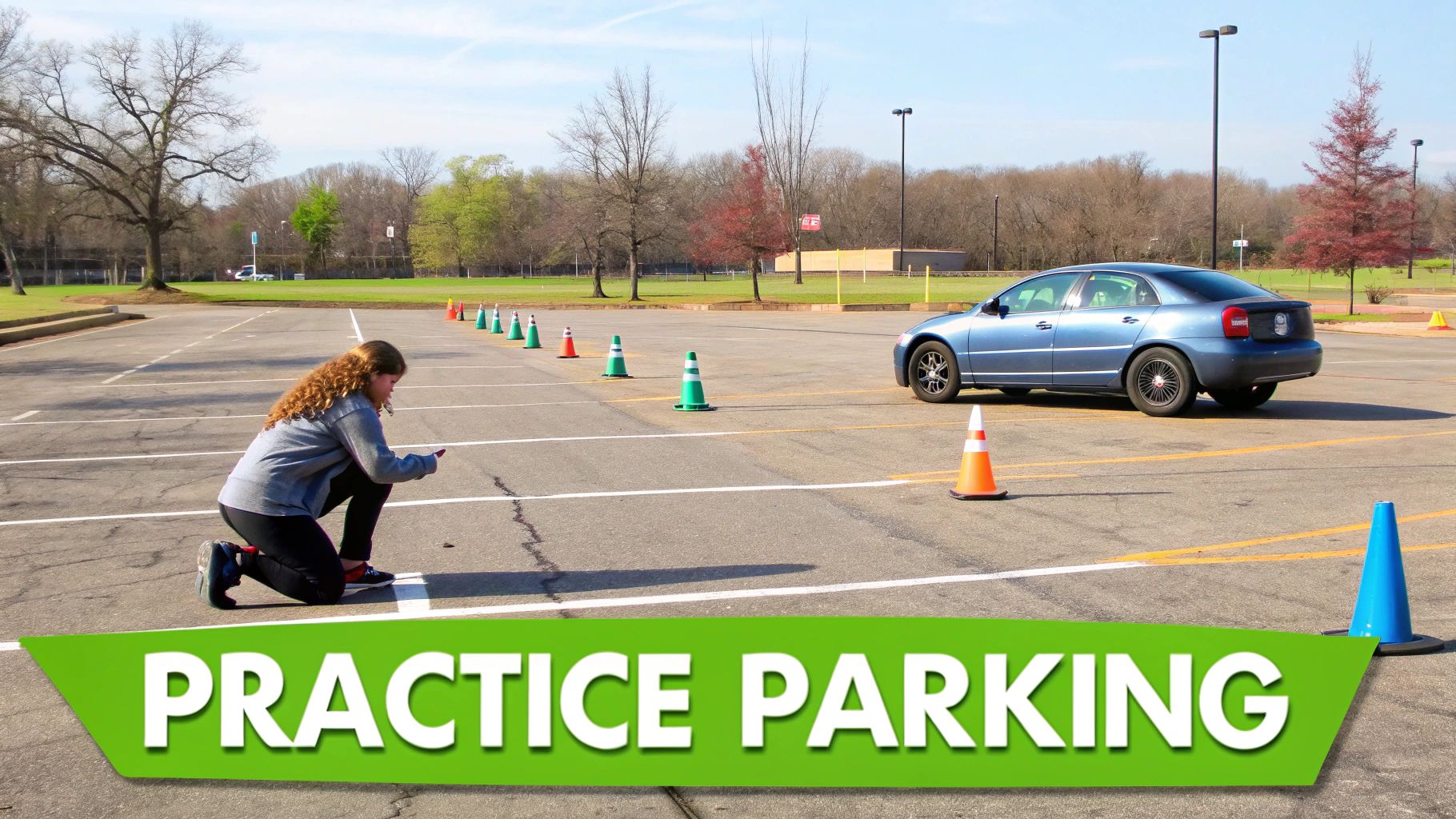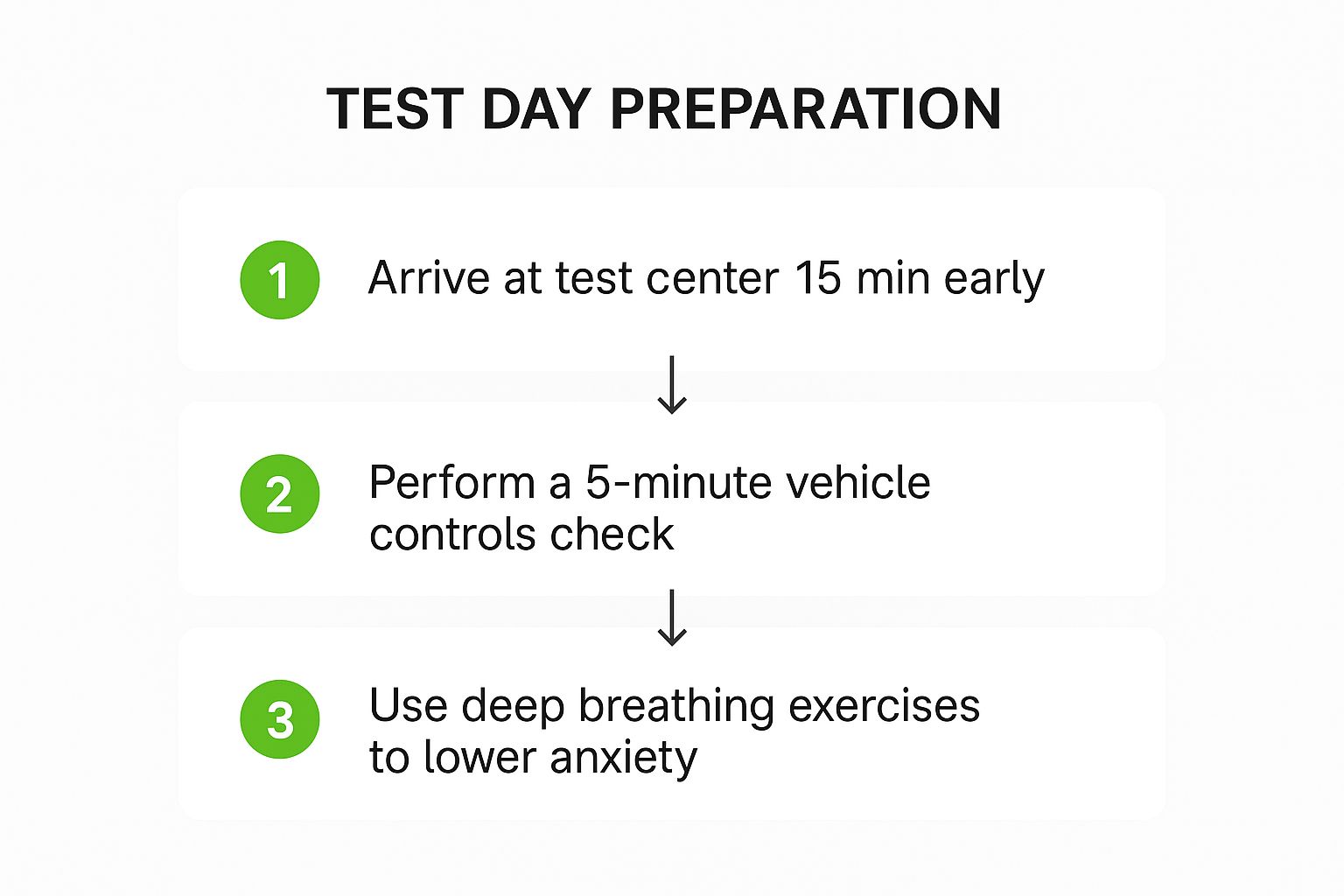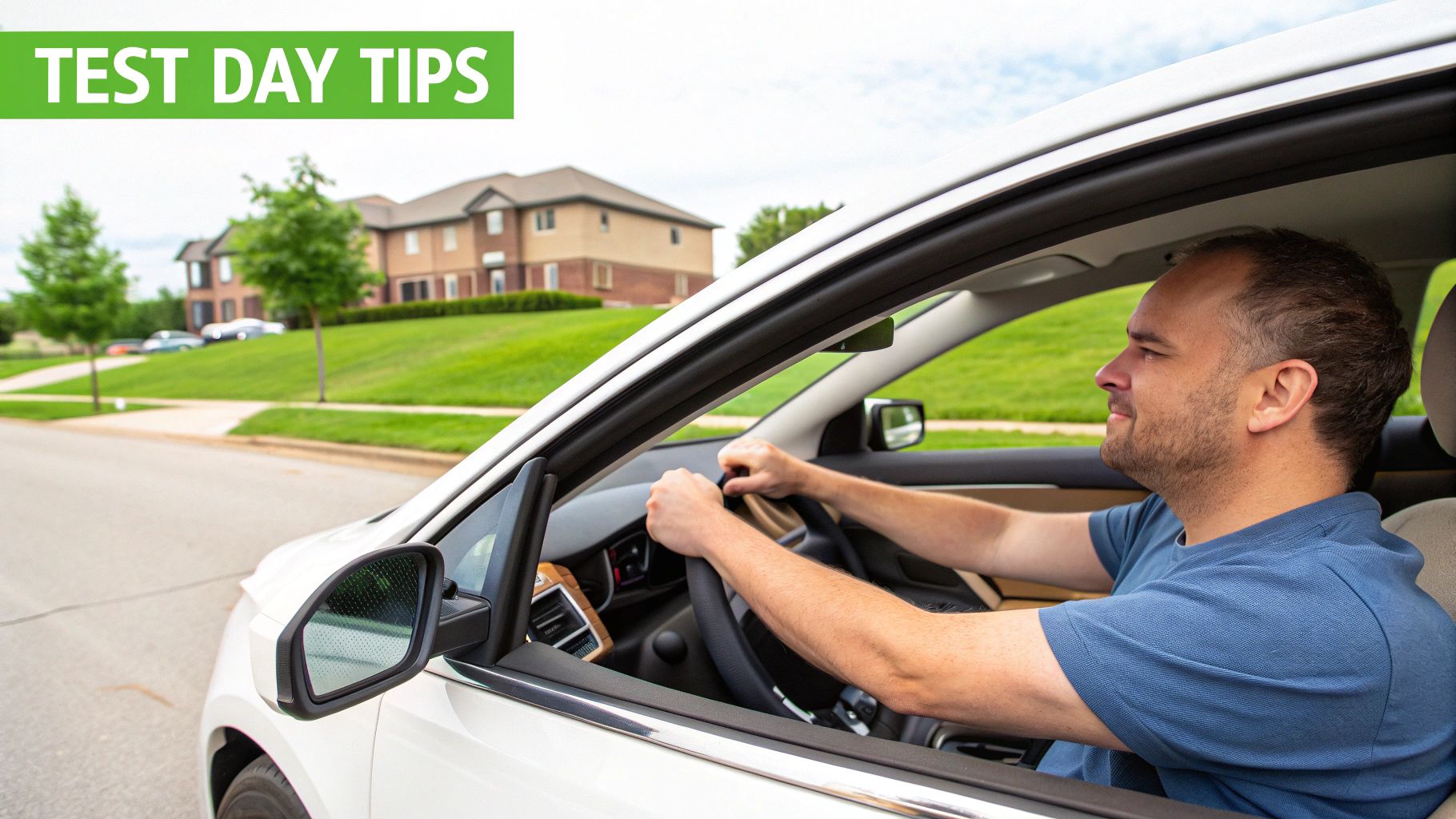Passing your driving test quickly isn't about luck; it's about having a smart, focused game plan. The whole thing really boils down to three key parts: picking an intensive way to learn, getting your theory and practical skills sorted at the same time, and knowing the tricks to bag an early test date. Get these three right, and you’ll drastically cut down the time it takes to go from learner to fully licensed driver.
Your Fast-Track Plan to Passing the Driving Test

Feeling the pressure to get your driving licence sorted? You're definitely not the only one. The road to getting that full UK licence can seem incredibly long, but a clear, well-thought-out plan is your secret weapon. Learning how to pass your driving test fast isn’t about cutting corners—it’s about preparing efficiently and effectively.
The entire process really stands on a few core pillars. Once you get your head around these, you can map out a realistic timeline and sidestep the common pitfalls that trip up so many learners.
The Three Pillars of a Fast Pass
From my experience, the most successful fast-pass strategies always nail three critical areas. If you let any one of these slide, you’ll find your progress grinding to a halt, no matter how good you are behind the wheel.
- Your Learning Method: The first big choice you have to make is between traditional weekly lessons and a proper intensive course. For speed, an intensive course is a no-brainer. It completely immerses you in driving, which helps your brain lock in those new skills much faster.
- Mastering the Theory Test: This one is simple: you cannot book your practical test until you've passed the theory. If you're on a tight schedule, making this a day-one priority is non-negotiable.
- Booking Your Test Strategically: The massive waiting lists for driving tests are a huge bottleneck. Knowing how to hunt for cancellations and being open to different test centres can literally shave months off your wait time.
This approach gives you a clear roadmap. It takes you logically from understanding the highway code to proving you can drive safely and confidently in the shortest time possible.
The great news for anyone putting in the effort is that pass rates are actually on the up. The latest data shows the UK pass rate hit 49.0% in March 2025, a solid increase from 46.9% the year before. It really shows that quality, focused training pays off. You can dig into more of these stats over on the ADI Network Blog.
To give you a clearer picture, I've put together a table that breaks down the essential parts of a solid fast-pass strategy.
Core Components of a Fast Pass Strategy
| Component | Why It's Crucial for Speed | Key Action |
|---|---|---|
| Intensive Course | Condenses months of learning into weeks, building muscle memory quickly. | Research and book a reputable intensive driving course in your area. |
| Early Theory Test | Unlocks your ability to book the practical test; a mandatory first step. | Start revising immediately and book your theory test as soon as possible. |
| Test Booking 'Hacks' | Bypasses the standard long waiting times for a practical test slot. | Use cancellation finder apps and be flexible with test centre locations. |
At the end of the day, your success hinges on your commitment and following a focused plan. Each element above plays a vital part in getting you test-ready efficiently, making sure you walk into that test centre feeling prepared for whatever the examiner throws at you.
Choosing Your Learning Path: Intensive vs Traditional Lessons
Deciding how you're going to learn is the biggest choice you'll make on your journey to passing your driving test fast. This isn't just about speed; it's about finding a rhythm that works for your personality, your deadline, and your wallet. The two main roads you can take—an intensive course or traditional weekly lessons—couldn't be more different.
https://www.youtube.com/embed/VWXgqPzADGQ
An intensive course, often called a ‘crash course’, is all about total immersion. Forget one hour a week. You’ll be behind the wheel for several hours every day, back-to-back, over a week or two. That constant practice is phenomenal for building muscle memory. Things like clutch control, mirror checks, and judging gaps at roundabouts become second nature far quicker simply because you don’t have a week to forget everything.
This approach is perfect if you’re up against a tight deadline, maybe for a new job that needs you to be mobile. But be warned: it requires a serious commitment of both time and money upfront. You'll need to clear your calendar and be ready for that initial investment.
The Case for Intensive Courses
Intensive learning works because it crams the entire learning syllabus into a short, sharp burst. This cuts out a really common problem with weekly lessons: skill decay. You know the feeling—spending the first 15 minutes of your lesson just remembering what you did last time. With daily sessions, each lesson flows directly into the next, building powerful momentum.
The real magic of an intensive course is the continuity. You literally live and breathe driving for a week or two. This cements tricky skills in your mind and sky-rockets your confidence. For anyone serious about passing their test quickly, it’s usually the most direct route.
If this sounds like it might be for you, our guide on intensive driving courses breaks down exactly what to expect and how to pick the right package.
What About Traditional Lessons?
On the flip side, you have the traditional pay-as-you-go weekly lessons. This is a much more paced approach, spreading your learning out over many months. For some people, especially very nervous learners, this slower pace is a godsend. It gives you more time to let the information sink in without the high-pressure feeling of an intensive week.
The obvious downside? It takes ages. It's a slow burn, and those long gaps between lessons often mean you forget crucial details. What you finally mastered about roundabouts one week can feel a bit hazy the next, forcing you to go over old ground and slowing down your real progress.
So, Which Path Is Yours?
Ultimately, it all boils down to a trade-off. What are you willing to exchange for that pink licence?
- Intensive Course: You invest a chunk of time and money upfront for incredibly fast progress and great skill retention. This is the one for learners with a clear goal and the ability to fully commit.
- Traditional Lessons: The weekly cost is lower and the schedule is more flexible, but the timeline to get test-ready is much, much longer. It suits those with no real deadline or who genuinely prefer a slow and steady approach.
If your number one priority is to pass your driving test fast, an intensive course is built from the ground up to make that happen. It's a structure designed for speed and efficiency in a way that spreading lessons over months just can't match.
Conquering The Theory Test: The First Hurdle

Before you even dream of getting behind the wheel for your practical test, there’s a critical gateway you have to get through: the theory test. A lot of learners trip up here, thinking it's the easy part, and it brings their fast-pass plans to a grinding halt. If you're serious about getting your licence quickly, you need to give the theory test the respect and attention it deserves.
This isn't about memorising answers from a book. Trying to rote-learn questions is a classic mistake and a sure-fire way to fail. The multiple-choice section is designed to test your actual understanding of the Highway Code, not just your memory. You need to grasp the logic behind the rules, not just recite them.
Nailing The Multiple-Choice Questions
Forget dusty old books and flashcards. The best way to prepare is with modern, interactive theory test apps. These tools are brilliant because they often use spaced repetition – a learning technique proven to help information stick.
An app will cleverly re-introduce questions you've struggled with, helping you patch up your weak spots. They also give you detailed explanations for every answer, which is absolutely essential for building that deeper understanding of road safety. My advice? Don't even think about booking your test until you're consistently hitting over 90% in the mock tests.
A common pitfall is underestimating just how many questions there are. The official bank has hundreds, and you'll get a random selection on the day. You can't rely on luck; you have to put the work in.
Mastering Hazard Perception
The second part of the test, hazard perception, is where so many people come unstuck. It's all about spotting developing hazards early, but the scoring can feel a bit unforgiving. You score points for clicking as a hazard begins to unfold, but clicking randomly, too early, or too late gets you zero.
The secret is to avoid the "click frenzy." Don't just click at every car or pedestrian. You need to learn to spot situations that could become a hazard. Think like a driver: a ball bouncing into the road might be followed by a child, or a bus at a stop could mean people stepping out without looking.
- Practice with Simulators: Get on the apps and online simulators that replicate the real test's video clips and scoring system. This is the only way to dial in your reaction times.
- Talk it Through: As you watch the practice clips, try saying out loud what you see. "Okay, car indicating to pull out," or "Cyclist ahead, might wobble." This forces you to actively scan and analyse, turning you from a passive viewer into an engaged driver.
Getting this first hurdle out of the way on your first attempt is the foundation of any successful fast-pass plan. For a deeper dive, our guide on passing the theory test has plenty more strategies to make sure you keep your journey to a full licence moving at speed.
How to Find and Book an Earlier Driving Test
So, you’ve smashed the theory test and you're feeling ready to go. The only problem? You log onto the DVSA booking system and find yourself staring at a waiting list that seems to stretch for months. It’s a classic roadblock for any learner driver eager to get their licence, but it’s not a dead end.
If you’re smart about it, you can jump the queue and find a test slot much, much sooner.
Frantically refreshing the booking page all day is a recipe for frustration. A much better approach is to be strategic. The DVSA tends to release new batches of test slots on Monday mornings, so being logged in and ready to go around 8 am can give you a real advantage.
Using Technology to Your Advantage
The real game-changer here is a driving test cancellation app. These brilliant little tools are designed to do the hard work for you, constantly scanning the DVSA system 24/7 for last-minute cancellations at your preferred test centres.
When a slot opens up, you get an instant notification, letting you grab it before anyone else even knows it’s there. It’s a small investment for a massive head start. For a deeper dive into how these work, check out our guide on fast track driving test booking.
Don't just fixate on your local test centre. Being a bit flexible on location can slash your waiting time. A centre just a few miles down the road could have slots available weeks or even months earlier.
Your choice of test centre affects more than just the wait time. It’s a well-known fact among instructors that pass rates can vary wildly from one centre to another. While the national average in Great Britain sits around 48.5%, picking a centre with a higher success rate can provide a subtle psychological edge.
Preparation Is Everything
Once you’ve nabbed that earlier test date, the clock is ticking. It's all about making sure you’re truly ready. The infographic below lays out a simple but effective routine to follow on the big day.

As you can see, getting ready isn't just about nailing the manoeuvres. It’s about getting your head in the right space so you can perform your best when it really counts.
Mastering the Skills That Matter on Test Day

Passing your driving test isn't just about following the Highway Code; it's about showing the examiner you have confident, safe control over the car. They need to see that you can handle real-world driving situations calmly and decisively, not just tick off a checklist of basic skills.
The mindset you need is to shift from just 'trying not to fail' to actively 'proving you can drive'. Every gear change, every turn, and every manoeuvre should look smooth and feel controlled. It's this quiet confidence that really makes the difference between a pass certificate and the dreaded "I'm sorry…"
From Hesitation to Decisive Action
Hesitation is a classic test-day mistake, especially at junctions and roundabouts. The examiner is looking for you to make safe, steady progress. Lingering at a perfectly clear junction for too long screams a lack of confidence and poor judgement of traffic flow.
The trick is to blend sharp observation with clear, decisive action. Always approach a junction with a plan. Assess the traffic patterns early, spot your gap, and when it’s safe, go for it without any last-minute dithering. Striking this balance is absolutely vital if you want to pass your test quickly.
Your goal is to make the examiner feel like a passenger, not a supervisor. When they can sit back and relax because your driving is predictable and safe, you know you’re on the path to passing.
Nailing the Manoeuvres
The DVSA has a few manoeuvres they can throw at you, and you need to be polished at every single one. Whether you’re asked to parallel park, bay park, or pull up on the right, the core principles are always the same: slow speed, great observation, and accurate steering.
Here's what to focus on for each:
- Pulling Up on the Right: It sounds easy, but it’s an observation minefield. You have to be meticulous with your mirror and blind spot checks before crossing the road, and again before moving off to rejoin traffic.
- Parallel Parking: This one is all about your reference points. Your instructor will help you find specific points on your car that signal exactly when to turn the wheel. Don't rush it—accuracy trumps speed every time.
- Bay Parking: Whether you're driving in forwards or reversing in, constant, all-around observation is non-negotiable. Avoid staring into one mirror. Keep your head moving, scanning everywhere, and be ready to adjust your path if needed.
Beyond Driving: The Independent Drive and 'Show Me, Tell Me'
The independent driving section, which takes up about 20 minutes of the test, is your moment to really demonstrate you're ready for the road. You'll be asked to follow either a sat nav or road signs. The examiner wants to see that you can plan your own route and drive safely without constant prompting.
If you take a wrong turn, don't panic! It’s a test of your driving ability, not your navigation skills. Just stay calm, continue driving safely, and the examiner will guide you back on track.
The 'show me, tell me' questions are easy marks if you've done your homework. You'll get one ‘tell me’ question before you start driving and one ‘show me’ question while you're on the move. Rehearse explaining how to check the engine oil and practising how to demist the windscreen until you can do it without thinking.
The UK driving test is tough, and the official stats prove it. In 2024, the pass rate hovered around 48.2%, meaning fewer than half of the people taking it pass. You can explore more about UK driving test data on the RAC website.
Got Questions About Passing Fast? Let's Get Them Answered
When you're aiming to get your licence in record time, you're bound to have questions. It's totally normal. Getting solid, practical answers is the key to building a smart plan that actually gets you that pass certificate sooner rather than later.
Here are the answers to the questions I hear most often from learner drivers.
How Many Driving Lessons Will I Actually Need?
The DVSA often quotes an average of 45 hours of professional lessons, plus private practice. But honestly, for a fast pass, that number can be a bit of a red herring. It's not about the total hours you clock up; it's about the intensity and quality of those hours.
Think about it this way: an intensive course might cram 30-40 hours into just one week. This is often way more effective than dragging the same number of lessons out over half a year. Your brain doesn't get a chance to forget what you learned yesterday, which builds incredible momentum.
Forget the logbook for a second. The real sign you're ready for your test is when you can drive a full hour-long lesson without your instructor needing to give you any verbal help or corrections. They're the expert, and they'll know when you’ve truly got it.
Should I Take the Driving Test in My Own Car?
You can use your own car, but it's often more hassle than it's worth, especially if speed is your goal. The DVSA has a very strict checklist. Your car needs to be fully taxed with a valid MOT, and it must be insured specifically for a driving test—your standard policy probably won't cover it. On top of that, it must be completely roadworthy with zero warning lights on the dash.
You'll also need to fit an extra interior mirror for the examiner and display L-plates on the front and back. For a 'fast pass' approach, this just adds extra stress and things that could go wrong on the day.
Frankly, it’s much simpler to use your instructor's car. It’s the one you know inside and out, you’re used to its bite point and the specific reference points for manoeuvres. Plus, it has dual controls, which examiners appreciate. That familiarity is a huge confidence booster when the test-day nerves kick in.
What are the Top Reasons People Fail Their Driving Test?
Knowing why others fail is like getting a cheat sheet for what to focus on. The DVSA's own data points to the same mistakes catching people out time and time again.
Here are the big three culprits that lead to an instant fail:
- Observation at junctions: This is the number one test-failer. Pulling out when it isn't safe is a guaranteed major fault. You have to be meticulous.
- Incorrect use of mirrors: Forgetting to check your mirrors before changing speed, direction, or even just stopping is a classic error. It needs to become second nature, a habit you don't even think about.
- Poor steering control: This covers everything from drifting out of your lane to mounting the kerb while trying to parallel park. Smooth, consistent control is non-negotiable.
If you want to pass quickly, you need to drill these fundamentals relentlessly. Your goal is to make observation, mirror checks, and vehicle control feel completely automatic.
Ready to stop waiting and start driving? At Fast Pass Driving Courses, we specialise in booking intensive courses and finding you an early test date, helping you get on the road weeks or even months sooner. Find your perfect course today at https://fastpassdrivingcourses.co.uk.

